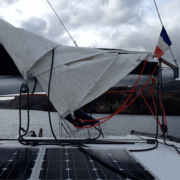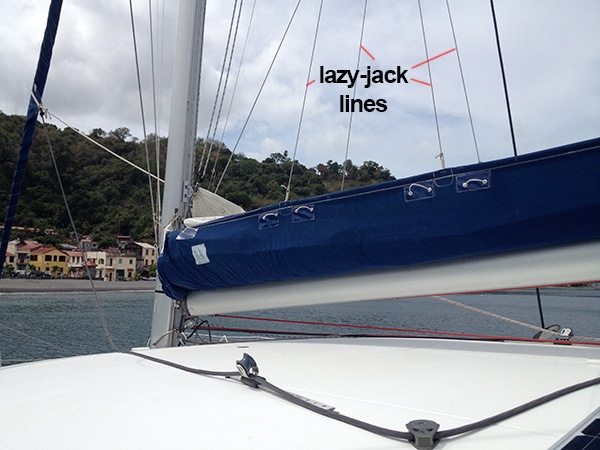Bareboat Chartering – Shaking out the Bareboat Charter Dust
If you like this post – please LIKE it via facebook thanks it helps us grow
Hi – Grant Headifen here. I’m about 3 days into a Bareboat Charter trip in Martinique in the Caribbean. This is one of approx. several dozen such trips all over the world that I have taken. I don’t say that to make you jealous or create envy, I say it to present that even with this amount of experience, things still “go bump in the night”. i.e. stuff happens and you should be prepared and expect things to happen. The good news is that if you’ve got the knowledge, then you will know what to do. Armed, you can now expect the expected.
The point is that this is an unfamiliar boat with unfamiliar gadgets and different ways of running lines and most likely, crew that have never done this before. Thus, your first day or so is going to be spent shaking out the Charter dust. And on top of that, inexperienced people (non-NauticEd students) have likely had the boat before you and screwed a few things up which were not caught by the Charter Base on turnaround. etc etc. More things to expect to go wrong.
Embedded here then is an incomplete list of items that’ll help you get faster acquainted with your boat and keep you in vacation mode i.e. save you money from not breaking stuff. Breaking stuff means a trip back to the base or waiting for the base to come to you.
Things to Expect
Raising the main
The mainsail is usually stowed on a charter boat in a stac-pac like this. Lazy-jack lines guide the mainsail down into the stac-pac when lowered
The lazy-jack lines and the boom-toping-ift are notorious for catching the battens on the way up. Watch them like a hawk. You should loosen the mainsheet a little to allow the boom to swing. This helps keep the mainsail centered along the boom as it goes up. The helmsperson needs to motor directly into wind. A big mistake is that the helmsperson watches the sail going up and tries to steer according to whether the sail is too far one way or the other. This sends the boat all over the place by oversteering. Rather, have your helmsperson steer to a point on land (or a cloud) into the wind. They then adjust their heading according to land but do not steer according to the sail – the boat will be all over the place. It is better yet to have the persons raising the main to tell the helm to steer 10 deg port or starboard depending on their observation of the battens.
A crew member also needs to be designated to keep a watch out for traffic, fishing pots, reefs, shallow areas, and land ahead. It is easy to get distracted by the sail difficulties and run right up onto the first reef out of the harbor. Like … embarrassing!
With a roached mainsail, the battens will even get caught on opposite sides of the boom-topping-lift. Watch out for this as the main goes up.
Additionally, reefing lines are always going to get caught up on your first mainsail raising. The last person who stowed the reefing lines will have probably pulled them in tight to clean up loose lines. That means as you raise the main, you have to make sure that they feed properly out. Sometimes they will be even wrapped around the outer end of the boom which is an impossible place to reach when the boat is swaying around – best check that before you leave the dock.
Other times the reefing lines will get caught in the jammers at the gooseneck end of the boom. You’ll need to be aware of this as the main raises.
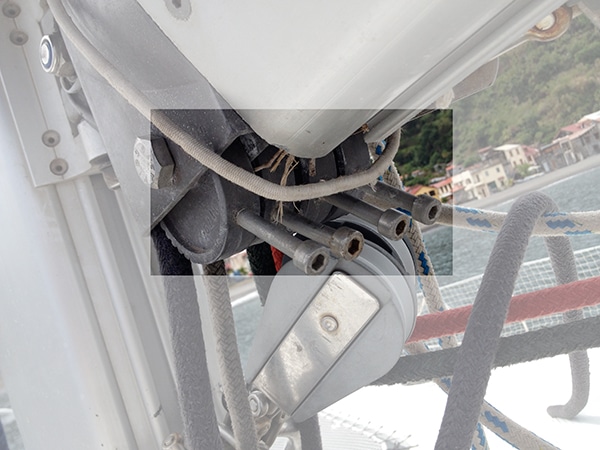
Reefing Jammers
These are the gooseneck reefing jammers. Make sure they are loose to allow the reefing lines to slide through.
Don’t pull the reefing lines in as you lower the mainsail – instead stow them on top of the sail stac-pac in their natural condition as the main lowers.
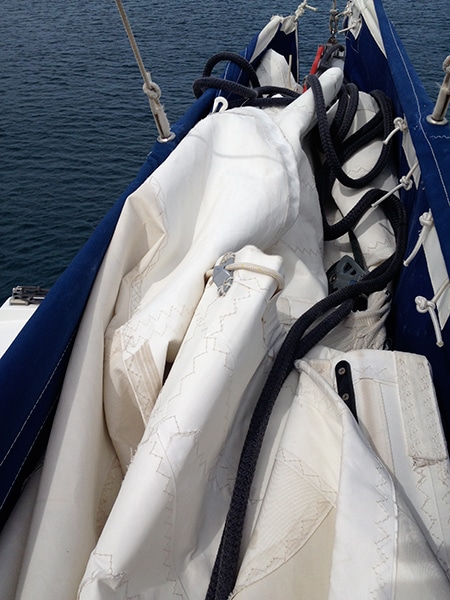
Reefing lines stow in stac-pac
Reefing lines are stowed on top of the sail in the stac-pac. Don’t pull them in – it only makes the sail raising difficult.
Once you lower the mainsail, the sail and reefing lines are going to look like this.
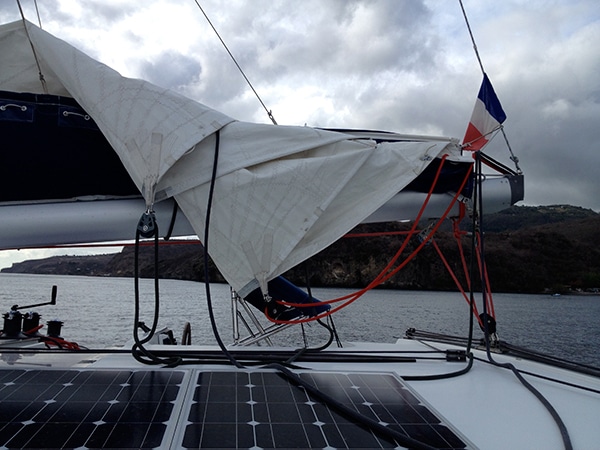
After the drop
Don’t allow the reefing lines to drape out of the stac-pac over the boom, they will swing up and over and tangle in absolutely anything without you noticing.
This is a real picture of the reefing line which swung out and wrapped itself around the deck broom. This picture was not staged it really happened.
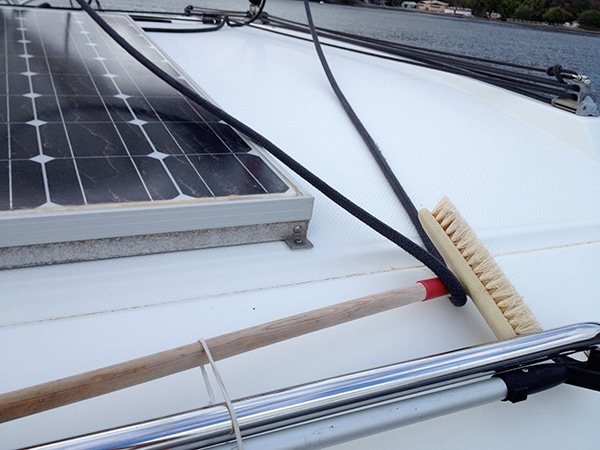
Reefing lines catch on anything
Instead, after the drop, do a clean-up of the reefing lines and the sail.
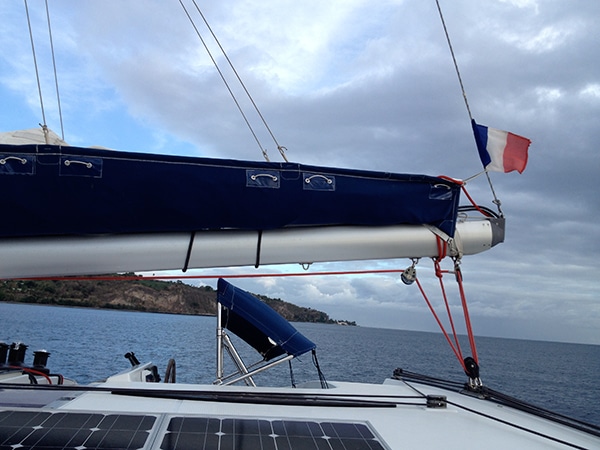
Cleaned up Stac-Pac
Then go around and do a clean-up of all the lines for a tidy ship.
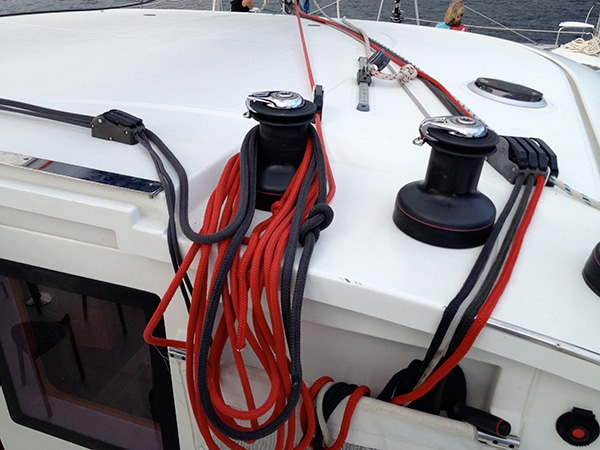
Tidy your lines
Once in Tahiti, the dual halyard lines were twisted about 4 times around each other – this doesn’t look like a problem when the sail is down in the stac-pac but as it gets near the top of the mast the twist doesn’t allow the sail to go fully up. If this is the case – ask the Base to take out the twist before you head out – just untwisting the block will not fix this – it is systemic with the halyard line and the twist has to be taken all the way out of the line to the end.
The big rule is watch watch watch as you raise the main and if the main halyard is tensioning up really tight, then something is really wrong – STOP and look.
One time in Tonga we even lost that main halyard up inside the mast – yes my fault for not watching but the last charterer had untied the figure-of-eight-stopper knot in the end. Whaaaa!
Lessons: – Before you leave the dock, trace all the reefing lines. Look to see what lines are pre-screwed up. Make sure they are ready for feeding out. Become very familiar with all the lines (including the ends of them). Trace them with your eyes before, during, and after raising.
Without a doubt, every time when you are raising the main you will need to lower the sail a little to get the battens to come up in between the lazy jacks. Just get used to it. Watch out also for the boom-topping-lift.
Genoa unfurling.
The genoa furling drum is a potential area of a tangled mess. An overwrap in the drum will cause difficulty when furling the genoa back in. Watch the drum like a hawk as you unfurl the sails. Keep back tension on the furling line using just one wrap around a winch or use an extra crew member. If the furling line is allowed to spool in loose, overwraps will occur and worse yet the line may spin off the drum and into the area below or above it. This can be a disaster. In Martinique this caused about a 30 minute untangle job near sun down as we were coming into an anchorage.
Things to check before you leave the dock
Light Bulbs and Switches
Prior to leaving the dock, do a full check of all light bulbs. Our dining light bulb was out – fortunately, we were able to fix it. In checking all the bulbs you’ll also learn where all the switches are. Sometimes the boat manufacturers put them in obscure places.
Fans
Check the operation of cabin fans prior to leaving the dock. The last thing you want is a whining crewmember.
Wind Scoops
Some bases have them some don’t. The closer to summer you are the more recommended these are. A wind scoop is a small parachute-type contraption that directs wind down into your cabin. Check for existence and ask. Also, ask to have the base show you how to set up. They are a bit tricky at first.
Windlass reset
Make sure you know the position of the windlass reset – if you don’t know what this is – hmmmmm – take our Bareboat Charter Course.
Waste Holding tanks
During your boat briefing, ensure you learn how these work on your boat. Unfortunately and unbelievably, some charter companies still allow a no-holding-tank set up or worse yet some permanently shut out the holding tank because they can’t be bothered explaining how a holding tank works to noneducated charterers. This is a crying shame. Nice harbors are filled with boat excrement. Voice your opinion to the base manager if they engage in this poor behavior.
Heads
Check proper operation. I’m pretty sure you’d rather have the base fix a head problem than you at sea.
Cooler drain plug
Keeping water in your cooler keeps ice around longer. If the drain plug is missing, you’ll be battling the ice situation all week.
Electronics
Time spent at the dock checking the electronics before you go out is going to be worth it. Often times the wind meter or autopilot have problems.
Dinghy Engine
One time in the BVI the last charterer did not screw on the engine tight enough. The base failed to check it and 1 hour out we were dragging the engine in the water behind the dinghy on its safety line. It took 4 days to get the engine running properly after spending time cleaning out the carburetor et al.
Dock Lines
One time in Greece we did not have enough dock lines. Med mooring was a challenge without enough. Then when we got back to base they charged us for loosing one.
Powering Your Devices.
A lot of boats these days have a built-in inverter to convert 12v into 110/240. But don’t assume that the boat will have your type of electric plug. They will either be a European plug or American and who can say what it will be. Bring a prong converter (not a transformer just a prong converter) most devices these days are smart enough to handle either voltage.
Stove, oven and broil/grill operation plus fridge and freezer
Check em – nuff said.
Data Roaming
Data roaming in foreign countries is very expensive. However, you can arrange with your carrier prior to leaving to get a data roaming package. This is advisable. You can then text and call using the WhatsApp App and use Dataplan to download weather data.
This blog was posted under sail in Martinique using prepaid international roaming data. Just as a gauge, during the first week, I used about 200 MB downloading emails and sending 50 or so WhatsApp texts and a couple of Skype voice calls.
Navigation
Download some useful Apps from your own internet connection at home. Get the Navionics App for your charter area. Get the Pocket Grib App for the weather.
Things you ARE going to screw up
I say this more as a challenge rather than a prophecy, however, these are items that easily get overlooked with the distractions of a fun vacation.
Hatches
Undoubtedly, the call of “close the hatches” to the crew receives a tertiary thought with the excitement of the upcoming sail. This means at least one or 2 crew mattresses are going to be soaked with salt water. Not that I’ve tried it but salted sheets don’t sound too appealing. As captain, it’s just best to run through the cabins yourself and check hatches.
Dinghy Painter
Before you leave the dock, check that this is long enough and in good quality. Then just assume that you are going to chop it up with the charter boat prop because invariably when you put your boat in reverse you’ll probably forget about the dinghy and back over the painter line. Here is the challenge – just try for one week not to chop up the painter. Tip as you come into a mooring, anchorage or dock secure the dinghy close to the boat so that this can not happen.
Dinghy Elbow
An excited crew member jumps on the dinghy and wants to drive. They start the engine without looking and drive their elbow into their spouse’s face.
Dinghy Beach Landing
Never allow the dinghy to sit sideways to the beach. One wave will teach you not to do it again.
Lines in the Water
Dock lines dangling in the water are a disaster because wrapping these around the prop in a marina with 20 knots of wind is the last thing you want. Get in the habit of checking dock lines prior to starting engines.
Fishing Line
As you come into a mooring, anchorage, or dock, wind in your fishing line. Obvious but… the excitement of a new anchorage overcomes the fishing line thoughts. Perhaps tie a handkerchief to the helm as a reminder.
Crew knots aka things that come undone in the night
Assume that crew knots are not knots.
Water Maker
Some newer boats have them. They use a lot of battery power and you will constantly be fighting your battery charge because most of your engine running will be supplying the water maker. From experience, having a water maker on board is not a license to use as much water as you want. Often you will find that the cost of diesel (to create electricity to create water) is more than the cost of water. That and the added amount of engine running time required to keep the batteries charged is almost not worth it.
Is that it?
Nope – this list is not exhaustive in fact it’s just a small part of chartering and a small taster for all the charter tips we give in our bareboat charter course. And as you can see, chartering is a lot different from taking your own boat out on the bay for an overnight in your local waterway. You might be a good sailor but that doesn’t necessarily mean you’re an equally good charterer. Like English and Math, they are two different disciplines
We highly advise becoming a NauticEd Bareboat Charter Master. With this certification, we teach advanced aspects of yachting and chartering and in particular, details on the above plus many more skills and tips to make your $5000 – $10,000 vacation go off without a hitch. The cost of the educational materials is just $175. This compared to just one boo boo, a trip back to the base because you or a novice crew member broke something, forgot to check something or even hurt someone is infinitesimal. The course package is comprehensive with over 40 hours of study materials from real sailor authors who have countless amounts of real global sailing experience. Yacht charter companies very much like the NauticEd Certification because it exceeds all of their requirements and your resume is complete.
Included in the Bareboat Charter Master Bundle of Courses is:
- Skipper Course
- Maneuvering Under Power
- Anchoring
- Bareboat Chartering
- Coastal Navigation
- Electronic Navigation
Then, once you log 50 days of sailing in the NauticEd logbook (with certain qualifying restrictions) you will be awarded the NauticEd Bareboat Charter Master Sailing Certification. We also advise a practical verification from one of our global sailing schools to gain the Practical Verification Stamp on your certificate.
Please enjoy your charter trip – have a ball.
Grant Headifen

